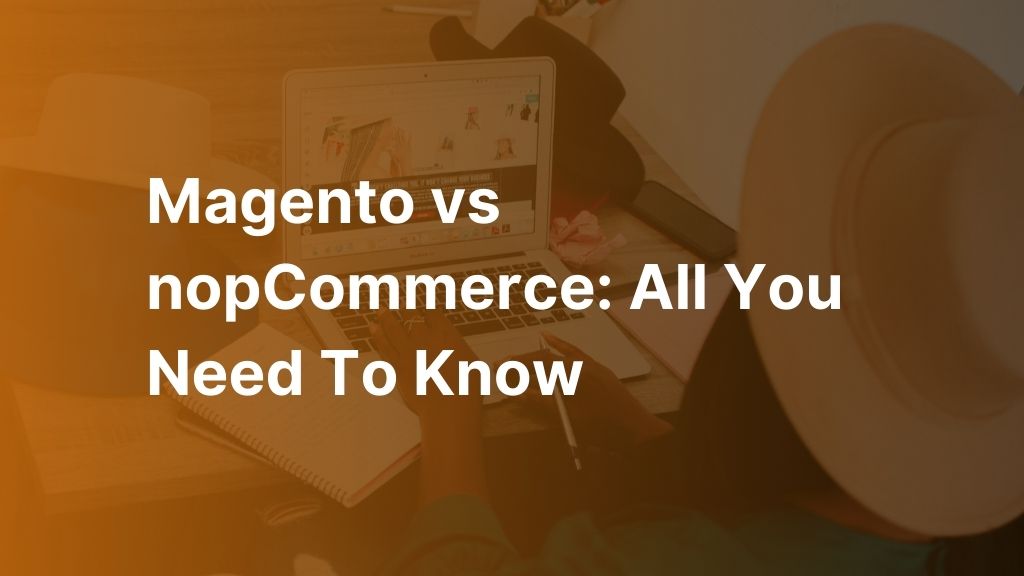Choosing the right eCommerce platform is crucial for effectively managing and growing your online business. However, deciding between leading options like Magento and nopCommerce can feel overwhelming. Each platform has unique strengths and caters to different needs, complicating the decision process.
To help you make an informed choice, we’ve put together a thorough comparison of Magento vs nopCommerce. This guide is meant to provide the insights you need to determine which platform is the best fit for your specific business goals.
A Brief Comparison Table Of Magento and nopCommerce
Table of Contents
Before jumping to the detailed explanation of Magento vs nopCommerce, let’s take a closer look at their fundamental differences and similarities. Then, you can consider which platform might better suit your specific business requirements and technical capabilities.
| Categories | Magento | nopCommerce |
|---|---|---|
| Target Customers | Medium to large businesses | Small to medium businesses |
| Pricing | Open-source free version; Enterprise paid | Free open-source; Additional costs for plugins and themes |
| Hosting | Self-hosted | Self-hosted |
| Themes | 75 themes Highly customizable Several advanced features, including mobile responsiveness, SEO optimization, integrations with various payment gateways | Over 300 themes Moderate customizable Integrations focus on ease of use |
| Customizability | Highly customizable with a steep learning curve | Highly customizable, easier to use than Magento |
| Extensions and Plugins | Extensive marketplace with both free and paid options | Wide range of free and paid plugins |
| Programming Language | PHP | ASP.NET |
| Performance | High performance, scalable | Good performance, scalable with less complexity |
| Community Support | Large, global community | Smaller community, but growing |
| Ease of Use | Requires technical expertise | More user-friendly interface |
Magento vs nopCommerce: Pros & Cons
Now that you have a high-level understanding of the differences between Magento and nopCommerce, let’s dive deeper into their respective strengths and weaknesses to help you make an informed decision.
Magento
Pros:
Extensive Feature Set: Known for its advanced marketing tools, customer segmentation, catalog management, and powerful analytics.
Customization and Scalability: Capable of handling large inventories and high transaction volumes, which makes it ideal for expanding businesses.
SEO Optimization: Comes equipped with robust SEO tools, including SEO-friendly URLs and Google sitemap integration.
Cons:
High Cost: The total cost of ownership can be considerable, particularly when including custom development and maintenance.
Resource-Intensive Hosting. Necessitates robust hosting solutions, which further add to the cost and complexity.
nopCommerce
Pros:
User-Friendly Interface. Those with limited technical resources can also utilize the platform to its simplicity.
Cost Efficiency: Requires minimal initial investment as it is open-source, with main costs related to hosting and optional premium support.
Customizability: nopCommerce’s themes, plugins, partial classes and events allow extensive customization for a unique online store.
Cons:
Smaller Community. Offers less community support and fewer plugins and extensions available compared to Magento.
Limited Scalability. May not perform as well under the demands of very large operations or extensive product catalogs.
Magento vs nopCommerce: The Detailed Comparison
Let’s break down some key differences between the two platforms to help answer the question: Which one is better Magento vs nopCommerce?
#1 Target Audience

Magento offers different editions tailored to various business sizes and needs. Magento Open Source, formerly known as Magento Community, is a free, open-source platform ideal for small to medium-sized businesses seeking customization without significant initial costs. This edition allows companies to expand functionality through extensions and is best suited for those with some technical expertise or access to developer resources.
Plus, Magento Commerce, which includes On-Premise and Cloud versions, is designed for large enterprises requiring a comprehensive, scalable eCommerce solution with full support, enhanced security features, and deeper integrations with other systems. These versions are particularly beneficial for businesses operating on a global scale or those needing advanced capabilities.
Similar to Magento, nopCommerce is another eCommerce platform, but it targets a somewhat different audience with its own unique features. Like Magento Open Source, nopCommerce is also free and open-source, making it accessible for small to medium-sized businesses that require customization without high initial costs. However, nopCommerce is built on the Microsoft ASP.NET framework, offering a preferred environment for businesses already integrated with Microsoft products or those preferring a .NET-based solution.
#2 Pricing
In terms of Magento vs nopCommerce cost, Magento offers a free Open Source edition, ideal for developers capable of managing their own hosting and maintenance, but operational costs can be substantial once you account for customization and security. For larger enterprises, Magento Commerce starts at around $22,000 annually, escalating with increased sales revenue, reflecting its extensive feature set and built-in support.
Here’s a more detailed estimate considering various elements that contribute to the cost of setting up and maintaining a Magento eCommerce site:
| Cost Category | Magento Open Source | Magento Commerce |
|---|---|---|
| License Fee | $0 (Open Source) | $22,000 - $125,000 per year |
| Hosting | $100 - $500 per year | $500 - $600 per year |
| SSL Certificate | $50 - $300 per year | $50 - $300 per year |
| Domain | $10 - $400 per year | $10 - $400 per year |
| Design | $0 - $5,000+ | $0 - $5,000+ |
| Extensions | $60 - $600 (per extension) | $60 - $600 (per extension) |
| Payment providers fees | 2.9% + $0.30 per transaction | 2.9% + $0.30 per transaction |
| SEO & digital promotion | $10,000 - 40,000 per year | $10,000 - 40,000 per year |
| Technical Support | Paid options available | Comprehensive support included |
| Annual Total Estimate | $6,120 to $56,400+ | $42,000 to $225,500+ |
nopCommerce is also free as an open-source platform but entails additional costs for hosting, maintenance, and optional plugins. Unlike Magento, nopCommerce’s premium support is more budget-friendly, beginning at $299 for three months—a more accessible price point for small to medium-sized enterprises.
#3 eCommerce Features
Magento truly shines when you need extensive control and flexibility. It excels at managing large, intricate catalogs – we’re talking tens of thousands of SKUs with varieties, bundles, and all types of customization.
The platform also makes it simple to have multiple online storefronts all tied to one centralized backend. This is huge for companies operating different brands or websites simultaneously. Where Magento really stands out though is its integration capabilities. Through the API and endless extensions. If you need tightly knit integrations for finance, inventory, order management, and beyond, Magento delivers.
Now nopCommerce might not have quite the same breadth of features out of the box. But for many small and mid-sized brands, it provides the essentials well – things like multi-store, mobile checkout, and user-friendly admin. Extensions also allow customizing functionality as your business grows.
The platform works smoothly for most everyday eCommerce tasks. And its user experience is easier for new teams to onboard versus the steeper learning curve of Magento. So if complexity isn’t a major concern today, nopCommerce can be a solid choice.
#4 Themes
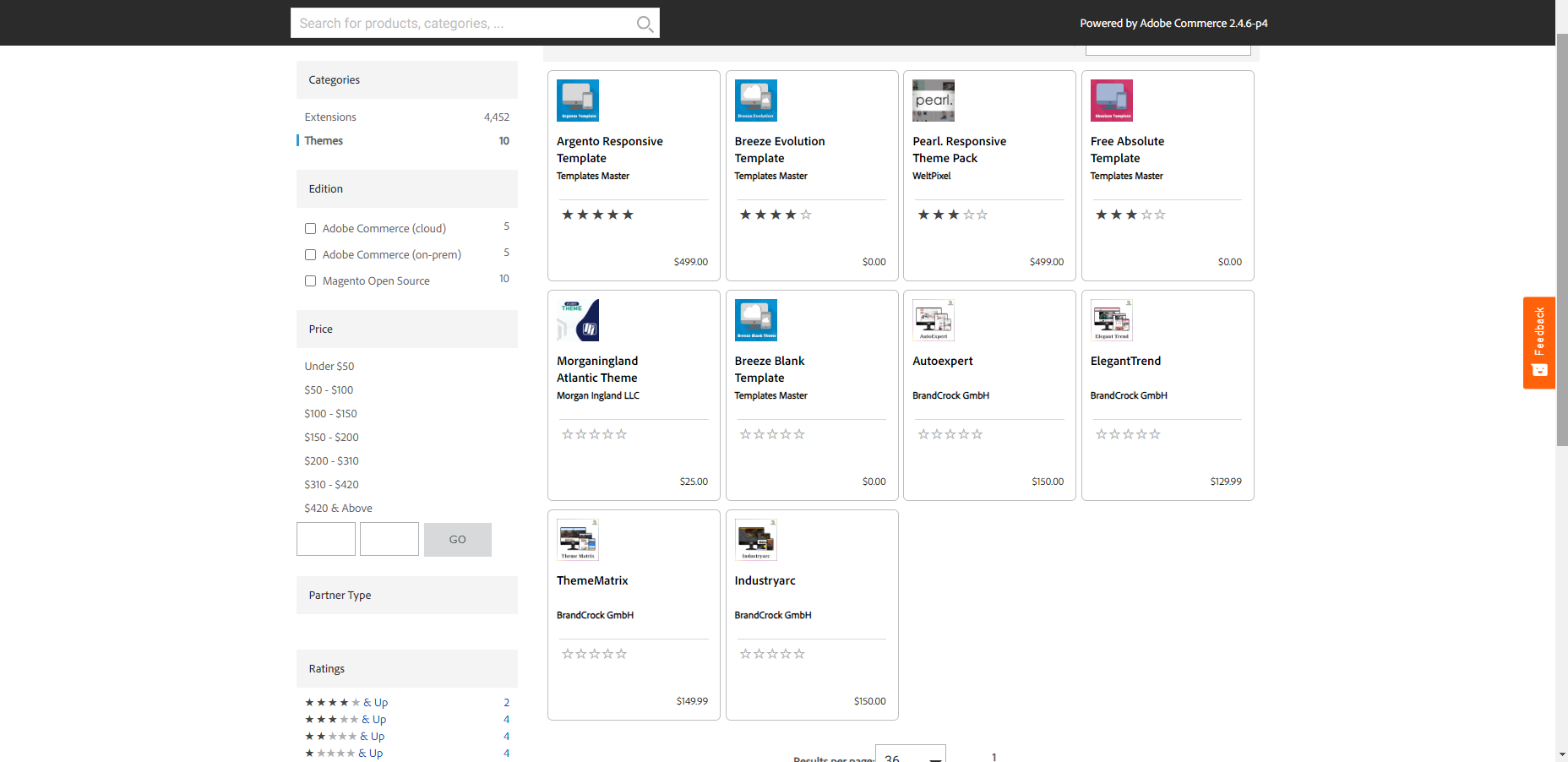
When it comes to themes, Magento opens up a wide array of options. The platform supports over 300 professionally designed themes, each built with responsiveness and SEO optimization in mind. Popular choices like Porto and Ultimo excel at flexibility, offering extensive customization for layouts, color schemes, and functionalities such as AJAX carts and mega menus.
Users can equip their stores with powerful features through Magento themes. Advanced search functions, one-click demo imports, customizable mega menus, and integrated blogs are just some examples – of crucial components for e-commerce success. The theme marketplace caters to diverse business needs across industries.
While the selection isn’t as large, nopCommerce themes aim for user-friendliness over quantity, totaling under 75 options. Their designs emphasize easy setup and built-in SEO/social media integrations. Perhaps most valuable for less technical shop owners, common theme tasks like configuration occur directly in the admin panel versus coding. This makes managing the look and feel much more accessible.
#5 Marketing
Magento really shines if you need powerful, customizable tools. It gives you customer segmentation to target specific groups like past customers or VIP buyers.
You can also do personalized promotions to really engage people one-on-one. Plus with push notifications, you have multiple ways to get your message in front of customers. All that is on top of detailed analytics that let you deeply analyze shopper behavior and continually refine your strategies.
Now nopCommerce is simpler overall compared to Magento. But it still packs some handy built-in options. Things like email marketing to keep customers coming back are right there. You also get tools to run reward programs and manage discounts through coupons. Reports are easy to generate too, so you always know what’s working when planning promotions.
#6 Security
Magento is renowned for its strong security features. It offers dedicated security patches and updates to protect against the latest vulnerabilities. Additionally, Magento supports two-factor authentication, secure payment integrations, and customizable access controls to enhance the security of eCommerce operations.
nopCommerce is built with security as a priority, regularly updating its platform to address new security challenges. It includes features like SSL support, prevention against XSS and CSRF attacks, and a comprehensive set of access control options. nopCommerce’s community also plays a vital role in supporting and sharing security best practices among its users.
#7 Add Ons
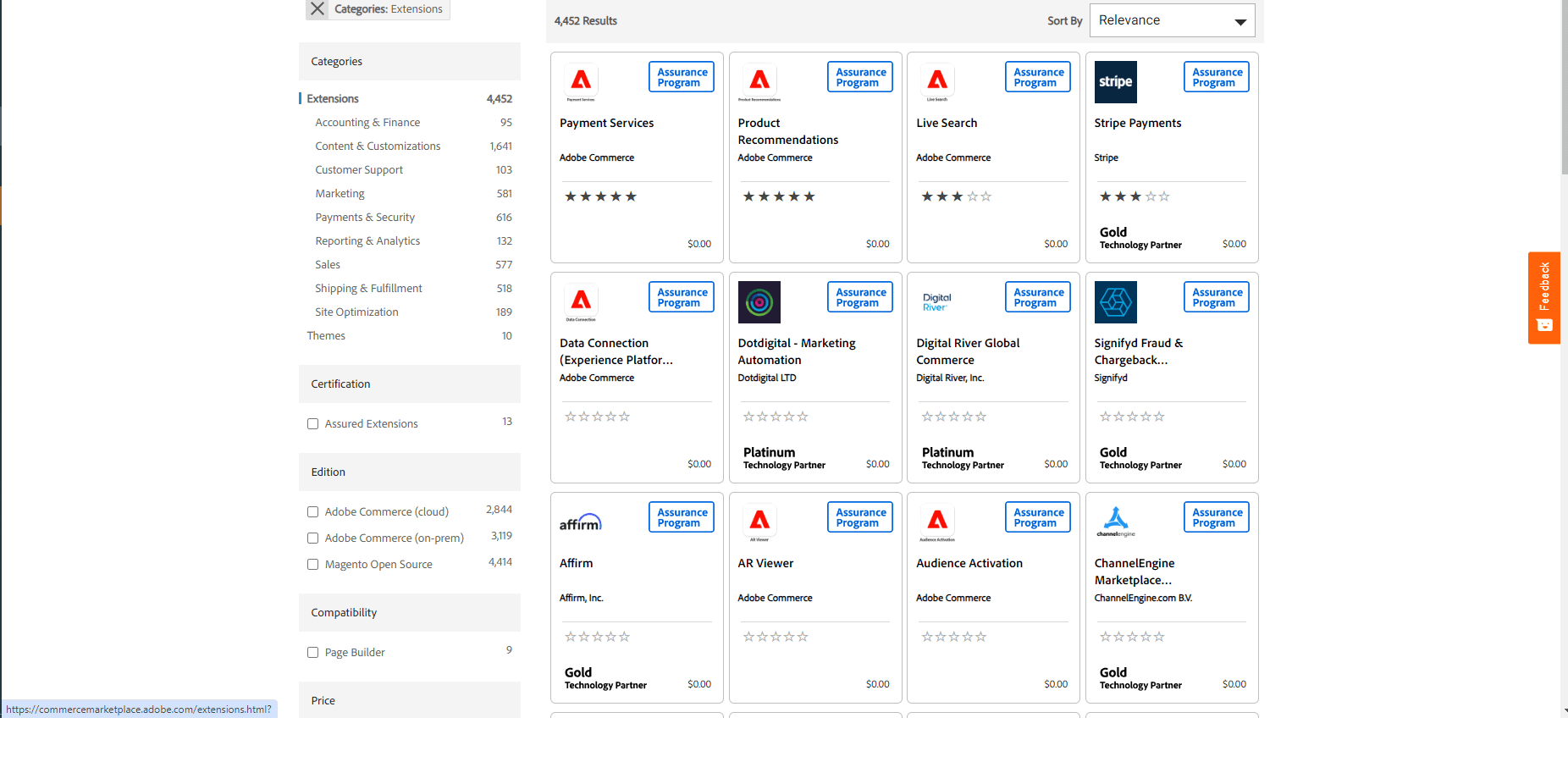
Both Magento and nopCommerce offer a wide range of add-ons to extend the functionality of their platforms. These add-ons can be found in their respective marketplaces and cover everything from SEO tools to advanced analytics, payment gateways, and customer relationship management integrations.
First, Magento’s marketplace is extensive, featuring thousands of plugins that cater to various needs. This includes Magento add-ons for marketing automation, customer support tools, and specialized e-commerce needs like subscription management or multi-vendor marketplace setups.
Similarly, nopCommerce provides a rich set of add-ons, though the selection is smaller compared to Magento. These add-ons are also focused on expanding the core functionalities of nopCommerce, such as payment integrations, theme enhancements, and marketing tools.
#8 Customization
For companies seeking to customize Magento without incurring high costs or extensive development time, partnering with our experienced agency can be an ideal solution.
We stand out as a prominent Magento 2 development company specializing in Magento development services. Here are some of our core strengths:
- Certified Testing Team: We boast an “ultimate” tester team certified as an “ISTQB Platinum Partner,” representing the highest level of testing ability nationally. This certification ensures that any customizations or developments undergo rigorous testing to meet high-quality standards.
- Experienced Development: With over 11 years of experience and thousands of projects implemented for renowned brands across 150+ countries, we have developed a deep understanding of the market and business knowledge. This experience allows us to build optimal e-commerce solutions tailored to various markets and business models.
- Commitment to Integrity: We prioritize integrity, ensuring that once the scope, pricing, and timeline are agreed upon, there are minimal changes. Any necessary adjustments are communicated transparently, fostering clarity and trust throughout the project implementation.
- Dedication and Client Retention: Our dedication to client satisfaction is evident in our 90% returning customer rate. We also offer time-zone flexibility, accommodating urgent requirements with quick deliverables.
#9 Scalability
Magento shines with its ability to handle large-scale businesses, supporting up to 250,000 SKUs and managing over 2,500 orders per hour with quick response times. This makes it ideal for businesses planning rapid growth or large volumes of traffic.
On the other hand, nopCommerce performs well for small to medium-sized enterprises (SMEs) and is customizable to a certain extent. However, scaling up with nopCommerce might require significant customization and might be better suited for businesses with access to development resources.
#10 Analytics & Report
Magento’s analytics tools cover a wide range of eCommerce metrics including user behavior, conversion tracking, and customer segmentation, which are enhanced by its ability to integrate with various third-party analytics services.
In contrast, nopCommerce offers basic analytics features that are sufficient for SMEs, focusing on sales statistics and customer activity but lacking the depth found in Magento’s offerings. Magento’s advanced reporting capabilities are particularly useful for larger businesses or those requiring detailed insights to shape their marketing and sales strategies.
#11 Customer Testimonials
Magento:
“The tool is very user-friendly and easy to use, it has multiple features in it which makes it a powerful tool. For me, the “Cart Price rules” and “Discount condition” modules have helped me a lot in creating and managing multiple coupon codes at scale.” – Aditya S. from G2.
“Adobe Commerce or Magento is on the top list of eCommerce friends. I like the fast speed, all inbuilt eCommerce functions starting from adding a product to delivery of a product to end customer, everything is well managed. Customer, order, cart, payments, shipping every function is already built, we just need to do the installation and can run a successful e-business in few days only. Thanks to Magento” – Gurpre from G2.
“The setup process could be challenging. Also, you have to evaluate if you really need the solution before hand.” – Victor D. from Capterra.
“It was quite challenging to set up everything for the first time. It could have a better help section to understand how everything will look and how it should work using all possible options.” – Janis T. from Capterra.
nopCommerce:
“Nopcommerce allows you to generate a store customized to the processes of each company, with its plugins, the structure is very well organized, which allows a developer to increase or adapt the purchase flow according to their needs.” – Diego Joshua C. from Capterra.
“The NOPcommerce is very easy to learn and straightforward eCommerce platform. The platform has powerful features that are scale to handle large format or multi brand store. The Solution is Free to use and the NOP community is very strong in helping each other.” – Arif K. from Capterra.
“A very solid & complete solution, but to less documentation to complete custom plugins. Also avoid using the badly generated API that they sell incomplete for almost 1000$ without support.” – Sébastien LN from Trustpilot.
“Limited integrations and challenging user experience” – Kevin F. from G2.
Websites Empowered By Magento
Monin

Currently, there are 120,047 websites actively utilizing the Magento platform. Let’s take a closer look at the two examples:
Monin
Monin’s website, powered by Magento, showcases the platform’s ability to drive sales and efficiently manage a wide array of products across international markets. When Monin decided to launch its eCommerce operations, Magento proved to be the perfect solution.
After migrating from Magento Commerce 1 to the more robust Magento 2 platform, Monin experienced remarkable growth – its revenue surged by an impressive 53% over the course of four years. But the benefits didn’t stop there. The transition to Magento 2 also resulted in a 20% increase in conversion rates and a 10% boost in revenue generated through email marketing campaigns.
Cox & Cox

Cox & Cox, a notable UK retailer specializing in homeware, furniture, and textiles, leverages Magento 2 to enhance its online presence. Upgrading to Magento 2 in 2016 allowed Cox & Cox to provide a powerful and flexible platform for its eCommerce activities.
The website impresses visitors with its wide range of visually appealing images and maintains robust eCommerce features, such as a strong main navigation panel and extensive sorting and filtering options. These elements help streamline the shopping experience, thereby potentially increasing conversion rates by making it easier for customers to find and purchase products
Websites Empowered By nopCommerce
While the number is smaller than Magento, there are currently 9,978 websites powered by nopCommerce. Scroll down for some examples of them!
Volvo Cars
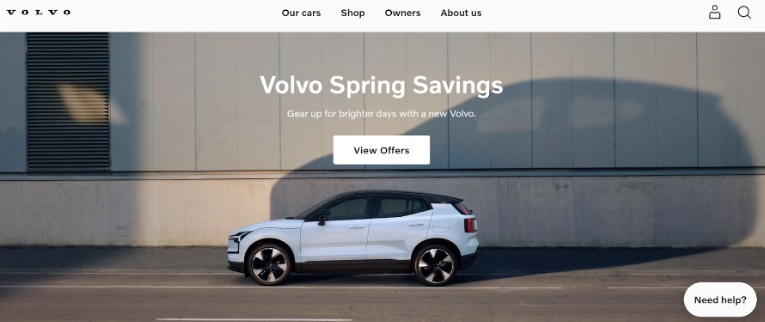
The Volvo Car Lifestyle Collection website exhibits a streamlined and accessible design, making it straightforward for customers to explore and purchase items. Utilizing nopCommerce could enhance this platform by integrating advanced eCommerce functionalities like flexible payment options, personalized product pages, effective marketing tools for promotions, and robust SEO practices to boost visibility. These enhancements can significantly improve user experience and conversion rates, making the shopping process more appealing and efficient for customers.
nopAdvance
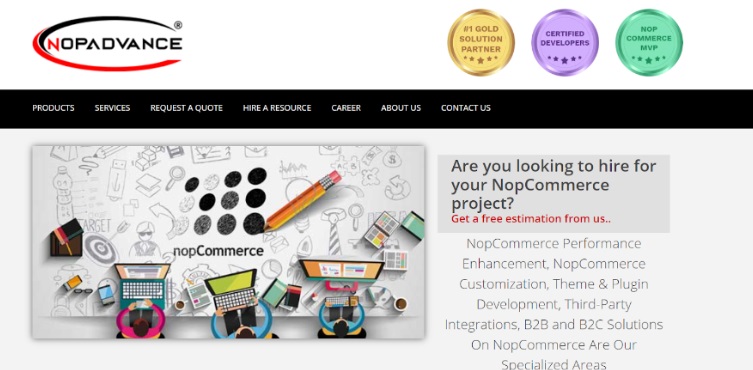
The case study on the nopAdvance website illustrates how using nopCommerce and a custom plugin, specifically NopAdvanced, significantly enhanced an online store’s performance. This combination improved the store’s SEO metrics by 150% and increased order volumes by 50% within three months.
Key features included a custom product builder that allowed customers to design awards and trophies interactively, which streamlined the ordering process and enhanced user engagement. This integration not only facilitated a better customer experience but also optimized backend processes for better efficiency and effectiveness.
Alternatives to Magento & nopCommerce
If you’re looking around for different platforms than Magento and nopCommerce, here’s a quick look at three other popular options: Shopify, WooCommerce, and BigCommerce. Each one has its own perks and drawbacks, catering to various types of businesses.
Shopify
For many entrepreneurs and small to medium-sized businesses, Shopify has become the go-to platform for building an online store. Its user-friendly interface and quick setup process make it incredibly appealing, especially for those without a technical background or those transitioning from brick-and-mortar to the digital realm.
One of Shopify’s biggest draws is its comprehensive, fully managed hosting environment, which takes the hassle out of server management and system maintenance.
With Shopify, business owners can focus on what they do best – running their business – without getting bogged down in the technicalities of running an eCommerce website.
Pros:
- Super easy to set up and use; you don’t need to be tech-savvy.
- It’s a hosted platform, which means Shopify takes care of all the server stuff.
- Has a big collection of apps to add more functions to your store.
Cons:
- It’s not as customizable as platforms that let you code things yourself.
- It can get expensive because of monthly fees and extra charges if you don’t use Shopify Payments.
You can dive deeper into how Shopify compares with others in this Magento vs Shopify vs WooCommerce article.
WooCommerce
WooCommerce is a top pick for small to medium businesses that already have a website on WordPress or businesses that prioritize extensive customization and control over their online store.
It integrates seamlessly with WordPress, making it an ideal solution for those who are comfortable with WordPress or who heavily rely on content marketing to drive sales. WooCommerce offers flexibility and an extensive range of customization options thanks to the vast array of plugins and themes developed for WordPress.
Pros:
- You can customize a lot, thanks to tons of plugins and themes.
- Starting is essentially free if you already have a WordPress site.
- There’s a large community for support and lots of help documents.
Cons:
- You need to handle your own hosting and keep your site secure, which can be a bit of work.
- Costs can add up with more plugins and themes for enhanced functionality.
BigCommerce
BigCommerce serves a diverse range of businesses, from new startups to large-scale enterprises looking for a robust, scalable eCommerce solution without the complexity of managing hosting and technical details.
It’s designed to support a variety of sales channels including online stores, physical retail, and social media platforms. BigCommerce is often chosen by businesses planning to scale quickly due to its strong inventory management capabilities and built-in features that support complex operations.
Pros:
- Comes packed with more built-in features than Shopify, which can be great for SEO and selling across multiple channels.
- You don’t have to pay extra transaction fees, no matter how you decide to handle payments.
Cons:
- Customization is a bit more limited compared to open-source platforms.
- Theme design choices might feel restrictive compared to what you can do on other platforms.
For a focused look at what BigCommerce offers, especially for wholesale businesses, you might want to read this BigCommerce B2B features article.
Conclusion
After comparing Magento vs nopCommerce, the final decision will depend heavily on your business size, growth expectations, technical ability, and budget. Magento offers a high-powered, customizable solution perfect for large businesses with complex needs. In contrast, nopCommerce provides an excellent starting point for smaller enterprises looking to make a straightforward entry into online sales.
Hope this helps make your decision a bit clearer! Let us know if any other questions come up as you evaluate these options.
